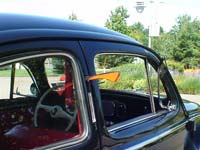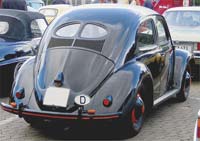












VW Beetle Brief History |
||
| Classic and Hot Rod Cars And Their Stories | ||
 Semaphor Turn Signals |
||
| History of the Volkswagen Beetle | ||
Literally, the word "volkswagen" means "people's car." Before 1930 there had been many efforts to create simple cars that everyone in Germany could afford. Almost all cars designed before 1930 cost more than the average worker's yearly wage. In 1933, Adolf Hitler met with Ferdinand Porsche to discuss Hitler's idea of a volkswagen. Hitler proposed a people's car that could carry 5 people, cruise up to 62 mph, return 33 mpg, and cost only 1000 Reich Marks, about $250.00. This was an opportunity for Porsche to push his idea of a small car forward, as it was to help Hitler get a real people's car for the citizens of Germany. In 1936 three prototype cars were initially produced, very similar to the KdF Wagen that appeared later having metal floors, swing axle rear transmissions, Porsche's front independent suspensions, and backbone floor pans. Of the several engines were tested, a flat four cylinder four stroke air-cooled engine was chosen. This 22.5 hp engine was basically the same engine used in Beetles through 1979. In 1939, several VW38s (preproduction) and VW39s (demonstration cars) were produced to show that the factory did work, and what the final version of the car would look like. Different from the prototypes, they had front hinged doors, split rear windows, and larger hoods. When the VW38s were introduced, Hitler abruptly changed the name of the car to KdF Wagen. KdF stood for "Kraft durch Freude" which meant "Strength through Joy." This greatly upset Porsche, he was not a Nazi party member and didn't support Hitler's use of propaganda when advertising the car. The KdF Wagen factory was busy pumping out Type 82s, Kübelwagens for the war. The Kübelwagen was a simple looking military vehicle that basically used the same parts as the KdF Wagen, but had a flat-sided body and increased ground clearance. It was essentially Germany's "jeep" in WWII with over 50,000 Type 82s produced, a modified version was later resurrected and sold as “The Thing”. The KdF Wagen factory was a prime target for allied forces during the war and was damaged heavily. Post war, the British Army took over and resurrected the factory under Major Ivan Hirst. By the end of 1945 they had produced more than 2000 cars from spare parts left in the factory. Within a year the factory had produced more than 10,000 cars, thanks to the British government. The company was renamed Volkswagen by the British who also renamed the factory town "Wolfsburg" after a local castle. The British sought to give control of the company to able hands: Ford thought it a waste of money, the French government refused, nobody wanted the company. In 1949 the British government relinquished control to the German government with Heinrich Nordhoff as senior executive. Volkswagen production steadily increased, Nordhoff's experience and knowledge proved invaluable. In 1950, Volkswagen commissioned a German coach building company, Karmann, to build Beetle convertibles, hence the special badges on VW convertibles. A few Volkswagens were imported into the United States in 1949 by Ben Pon, but only a couple were sold in their first year, sales remained slow until the mid 1950’s. In 1951, Volkswagen began to export a deluxe version of the beetle. There was already a "standard" Beetle available only in a dull gray color. The standard Beetles were spartan lacking synchromesh transmissions, exterior and interior chrome, and options one might expect as standard. Regular export cars were offered in several colors, they also had chrome and a radio. The American export cars had even more chrome and were the most elaborate in options and features. The American deluxe Beetles got hydraulic brakes in 1952, and lost their semaphores (flag-like turn signals) in 1955. Also in 1955,Volkswagen came out with a new model called the Karmann Ghia, using many parts from the Beetle to keep production cheaper the Karmann Ghia was a joint venture between Karmann (builds VW Beetle cabriolets) and Ghia. Volkswagen production kept increasing through the late 1950s with very minor changes occurring each year. Volkswagen had a very successful advertising campaign in the 1960s and the Disney movie “Herbie” portrayed the Beetle as a "love bug" really helped boost sales. By the mid-1960s, Volkswagen was producing over one million Beetles each year with 1969 being the most productive year. Ever increasing US government safety and emissions regulations pushed the Beetle to where it could not be adapted to keep up with other cars in the industry. Volkswagen stopped production of the Beetle sedan in 1977, and stopped production of the cabriolet in 1979.
|
||
Note: All Images And Stories On This Site Are Copywrited. Use Of Any |
||
 Great Pricing & Selection of Cameras and Accessories: Top Camera Mall |
||
|
||

